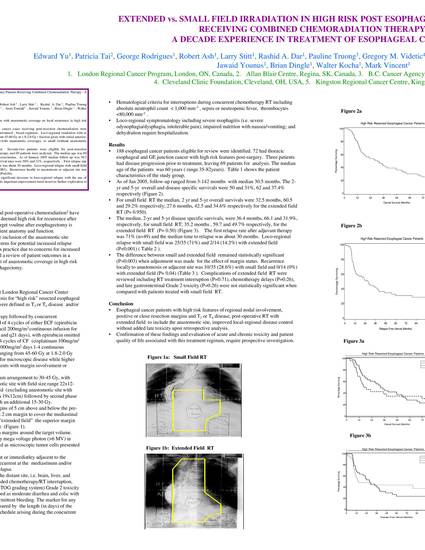
- Epidemiology,
- Oncology and
- Surgery
OBJECTIVE: To assess the impact of extended field irradiation with anastomotic coverage on local recurrence in high risk resected esophageal cancerpatients.
METHODS: From 1989-1999, high risk resected esophageal cancer cases receiving post-resection chemoradiation were reviewed. Adjuvant chemotherapy consisted of four cycles of fluorouracil-based regimens. Loco-regional irradiation with or without coverage of anastomotic site had radiation a dose range from 45-60 Gyat 1.8-2.0 Gy/fraction given with initial anterior-posterior/posterior-anterior arrangement with either extended (with anastomotic coverage), or small (without anastomotic coverage) field followed by oblique fields for boost.
RESULTS: One hundred eighty-eight charts were reviewed. Seventy-two patients were eligible for post-resection chemoradiation. Three patients had disease progression prior to therapy, and 69 patients were analyzed. The median age was 60 years (range 35-82 years) with 94% T2-3N1 and 65% were adenocarcinoma. As of January 2005 median followup was 30.5 months (range 3-142 months), the two-and five-year overall survival rates were 50% and 31%, respectively. First relapse rate after adjuvant therapy was 71% (n=49) and median time to relapse was about 30 months. Loco-regional relapse with small field was 25/35 (71.4%) and 2/14 (14.2%) with extended field (P<0.001). Recurrence locally to anastomosis or adjacent site was 10/35 (28.6%) with small field and 0/14 (0%) with extended field (P=0.04).
CONCLUSION: At a minimum of 5-year followup, there is significant decrease in loco-regional relapse with the use of extended field in high risk resected esophageal cancer patients. This important improvement trend deserves further exploration in prospective randomized clinical trials.
Available at: http://works.bepress.com/richard_malthaner/23/
